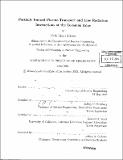Partially ionized plasma transport and line radiation interactions as the tokamak edge
Author(s)
Adams, Mark Lloyd, 1972-
DownloadFull printable version (7.401Mb)
Other Contributors
Massachusetts Institute of Technology. Dept. of Nuclear Engineering.
Advisor
Jeffrey P. Freidberg and Howard A. Scott.
Terms of use
Metadata
Show full item recordAbstract
Hydrogenic resonance line radiation interacts with the high-density low-temperature plasma at the tokamak edge. As a result, there exists a significant nonlocal plasma energy transport channel, local atomic level populations are altered by global plasma properties, and plasma transport is affected. In this dissertation, new theoretical and computational models of partially ionized plasma transport, which include line radiation interactions, are developed and then applied to the study of plasma phenomena at the tokamak edge. First, to include the effects of an external magnetic field on nonlocal thermodynamic equilibrium (NLTE) mlodels, TotalB, a computationally efficient spectral line shape code that describes the broadening of radiative transitions due to an applied magnetic field, the ion microfield, and electron perturbers, is developed using standard line broadening theory. Second, to enable the study of plasma transport and line radiation interactions, PIP, a partially ionized plasma transport model that includes the charge-exchange coupling of ions with neutral atoms, the transport of potential energy, the effects of resonance line radiation interactions on atomic rates, and the transport of an arbitrary number of atomic levels, is developed and coupled with an existing NLTE radiation transport model. Finally, the combined capabilities model is applied to the simulation of a tokamak divertor and the significant effect of line radiation interactions on plasma transport at the tokamak edge is demonstrated. In addition, since the solution of the radiation field is an integral part of the calculation, several spectroscopic diagnostic techniques are developed.
Description
Thesis (Ph. D.)--Massachusetts Institute of Technology, Dept. of Nuclear Engineering, 2003. Includes bibliographical references (p. 166-179).
Date issued
2003Department
Massachusetts Institute of Technology. Department of Nuclear Engineering; Massachusetts Institute of Technology. Department of Nuclear Science and EngineeringPublisher
Massachusetts Institute of Technology
Keywords
Nuclear Engineering.